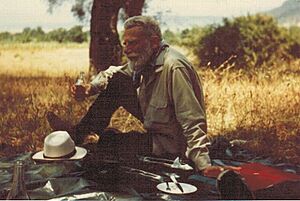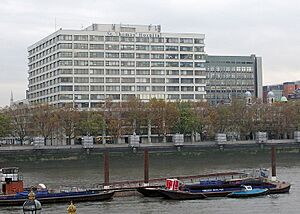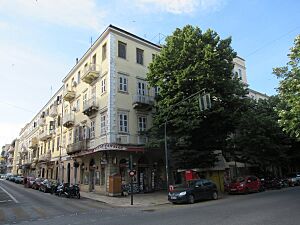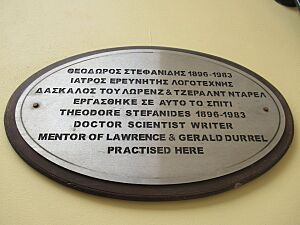Theodore Stephanides facts for kids
Quick facts for kids
Theodore Stephanides
|
|
|---|---|

Theodore Stephanides visiting Corfu with the BBC in 1967
|
|
| Born |
Theodore Philip Stephanides
21 January 1896 |
| Died | 13 April 1983 (aged 87) |
| Nationality | Greece, United Kingdom |
| Occupation | poet, author, translator, doctor, astronomer, naturalist, scientist, etc. |
| Spouse(s) | Mary Alexander |
| Children | Alexia Stephanides-Mercouri |
| Parent(s) | Philip Stephanides and Caterina Ralli |
Theodore Philip Stephanides (Greek: Θεόδωρος Φίλιππος Στεφανίδης; born January 21, 1896 – died April 13, 1983) was a Greek-British doctor and a polymath. A polymath is someone who is an expert in many different subjects. He is best known as the friend and teacher of writer Gerald Durrell.
Stephanides was also a naturalist, biologist, astronomer, poet, writer, and translator. His book Climax in Crete (1946) tells his story of the Battle of Crete. Military historians still use it today. His 1948 book, A Survey of the Freshwater Biology of Corfu, is a key book about the freshwater life on the island of Corfu.
He appeared in many books, like My Family and Other Animals by Gerald Durrell. He was also in Prospero's Cell by Lawrence Durrell and The Colossus of Maroussi by Henry Miller. He was also shown in several movies and TV shows. Four tiny water creatures are named after him.
Contents
Early Life in India and Greece
Theodore Philip Stephanides was born on January 21, 1896. He was born in Bombay, which was then part of British India. His father, Philip, was from Greece. His mother, Caterina Ralli, was of Greek descent but born in London.
Theodore's father worked for a British company with Greek roots. His mother was part of that family. Theodore spent his early years in Bombay. His family spoke only English at home, so it was his first language.
In 1907, his father retired. The family first moved to Marseille, France. Soon after, they moved to the Ralli family's estate in Corfu, Greece. Theodore was 11 years old when he started to learn Greek. He always spoke Greek with a strong British accent.
Serving in Wars
Stephanides was a gunner in the Greek army. He served on the Macedonian front during World War I (1917–1918). After that, he fought in the Greco-Turkish War from 1919 to 1922.
He later wrote a book called Macedonian Medley; 1917–1918. This book was based on a diary he kept during the war. He served in a quiet area for 18 months. He often helped connect with British and French soldiers. He could do this because he knew both English and French.
In 1921–1922, Stephanides faced a military trial. This happened because he refused to attend a service for King Constantine I of Greece. He disagreed with the Greek military leaders. He strongly supported Eleftherios Venizelos, a former prime minister.
Studying Medicine and Astronomy
After leaving the army, Stephanides moved to France. He studied medicine at the University of Paris from 1922 to 1928. He specialized in radiology, which uses X-rays to see inside the body. One of his teachers was the famous scientist Marie Curie. In 1929, he earned his PhD. His studies focused on how to use microscopy techniques.
While in Paris, Stephanides also studied astronomy. He was highly respected by Camille Flammarion, a French astronomer. Stephanides became interested in astronomy in 1914. He watched the Sun for two months and drew many sunspots. Because of this work, he joined the French Astronomical Society in 1915. He continued to observe the stars and planets throughout his life.
In the 1920s, Stephanides began translating Greek poetry into English. In 1925 and 1926, he published two books of poems. These were by Kostis Palamas and other modern Greek poets. He worked with George Katsimbalis on these translations. They met during World War I and became lifelong friends.
Life in Corfu and the Durrell Family
Stephanides returned to Corfu in 1928. That same year, he and his friend Philoctetes Paramythiotis opened the first X-ray lab in the Ionian Islands. They worked together there until 1938. A TV show called The Durrells showed a fun version of his work. In the show, young Margo Durrell helped him.
In 1930, Stephanides married Mary Alexander. Her grandfather was a British consul in Corfu. They had one daughter, Alexia Stephanides-Mercouri (1931–2018). Alexia was a good friend of Gerald Durrell. Theodore hoped they would marry, but World War II changed their plans.
Stephanides became very interested in freshwater biology in the 1930s. In 1936, the Greek government asked him to write a major scientific book. It was about the freshwater life of Corfu. This book was published in 1948. During his research, he found three tiny water organisms. They were named Cytherois stephanidesi, Thermocyclops stephanidesi, and Schizopera stephanidesi.
In the summer of 1935, Stephanides met the Durrell family. They had just moved to Corfu. He quickly became close friends with two of the Durrell brothers, Lawrence and Gerald. They remained friends for life. Gerald Durrell later said that Stephanides had a huge impact on him. Gerald was only ten years old and loved nature. Stephanides helped him learn how to explore. Gerald wrote, "Not many young naturalists have the privilege of having their footsteps guided by a sort of omnipotent, benign and humorous Greek god."
Both Durrell brothers wrote about Stephanides in their books about Corfu. Gerald wrote about him in his Corfu trilogy, including the popular book My Family and Other Animals. Lawrence wrote about him in Prospero's Cell. Stephanides also wrote his own memories of that time. These were mostly about Lawrence Durrell and his wife. Parts of his memories were published in journals. The full version came out in 2011 as Corfu Memoirs.
From 1938 to 1939, Stephanides helped fight malaria in Greece and Cyprus. This was part of a campaign by the Rockefeller Foundation. Earlier, in 1933, he wrote a report on how to prevent malaria in Corfu.
When Stephanides briefly returned to Corfu in 1939, he met Henry Miller. Miller later said, "Theodore is the most learned man I have ever met, and a saint to boot." When World War II started, Stephanides had to leave Corfu again. He only visited a few times after that. But he always remembered the island fondly.
World War II and Climax in Crete
During World War II, Stephanides was a British citizen. He served as a medical officer in the Royal Army Medical Corps of the British Army. He was a lieutenant and later a major. He served in Greece, Crete, the Sahara Desert, and Sicily.
In May 1941, Stephanides was in Crete. He was with the Allied forces when Germany invaded. The Allies had to retreat across the island to escape by sea. Stephanides had to walk in boots that were too big. This made him limp for a while. During the last part of their long march, he and another medical officer led about 100 injured soldiers. They walked openly under a Red Cross flag, with no weapons or helmets. They finally reached the beach and were taken to Alexandria by a ship called H.M.A.S. Perth.
In 1946, Stephanides published Climax in Crete. This book was his personal story of the Battle of Crete. Lawrence Durrell wrote the introduction to the book. He said it was very clear and accurate. Gerald Durrell called it "one of the best war books written." Many people praised the book. Military historian Antony Beevor used it a lot in his book Crete: The Battle and the Resistance.
Stephanides' parents died in Corfu during a German bombing in 1943. His wife Mary and daughter Alexia had moved to England in 1939. They stayed safe there until the war ended. They even lived with the Durrells in Bournemouth for some time.
After leaving Crete, Stephanides served in the Western Desert for two years. In the summer of 1943, he took part in the Allied invasion of Sicily. His experiences in the Western Desert are in his books Western Desert Scramble and Western Desert and Beyond. These books are kept in the Imperial War Museum in London.
Life in London After the War
After World War II, Stephanides left the British Army. He joined his family in London. In 1947, he and Mary divorced after 17 years.
From 1945 to 1961, Stephanides worked as an Assistant Radiologist at St. Thomas' Hospital in London.
After Climax in Crete was published in 1946, he wrote two science books. One was The Microscope and the Practical Principles of Observation (1947). This was a detailed guide on how to use a microscope. The other was A Survey of the Freshwater Biology of Corfu and of Certain Other Regions of Greece (1948).
In 2012, a British biologist named Peter G. Sutton praised A Survey highly. He said it "laid the foundation for future naturalists to study the aquatic fauna of Corfu." Sutton was amazed that so much knowledge about Corfu's water life came from Stephanides' original work. He also mentioned that most of Stephanides' notes and collections were destroyed in the war. But A Survey was saved by luck.
In July 1967, Stephanides went to Corfu. He helped Gerald Durrell and Christopher Parsons make a BBC travel documentary called The Garden of the Gods. Both Stephanides and Durrell appeared in the film.
Stephanides was very careful and knew a lot about Corfu and Greece. He also spoke both English and Greek perfectly. Because of this, the Durrell brothers asked him to check their books. He proofread Gerald's My Family and Other Animals and Lawrence's Prospero's Cell, among others.
Stephanides also published his own poems. His collections include The Golden Face (1965) and The Cities of the Mind (1969). He was highly praised as a poet. In 1973, he published a third collection, Worlds in a Crucible. A fourth collection, Autumn Gleanings, was published after he died in 2011.
He also kept translating the poetry of Kostis Palamas with George Katsimbalis. Stephanides also worked alone. He translated the Greek national poem Erotocritos, which was published after his death in 1984. He also translated many short poems by Sappho and other Ancient Greek writers. Only about half of his translations have been published so far.
In 1973, Stephanides published Island Trails. This book was a mix of fact and fiction about Corfu and other Ionian Islands. It was a collection of Greek folk stories he had gathered. Gerald Durrell wrote the introduction for this book.
On February 15, 1983, Stephanides was a "very special surprise guest" on the UK TV show This is Your Life. The show was about Gerald Durrell. This was the last time Stephanides and Durrell saw each other.
Theodore Stephanides died peacefully in his sleep on April 13, 1983. He passed away in London.
Legacy and Recognition
Four tiny freshwater crustaceans are named after Stephanides. These are Cytherois stephanidesi, Thermocyclops stephanidesi, Schizopera stephanidesi, and Arctodiaptomus stephanidesi. Different researchers discovered them in the 1930s.
A French scientist named Félix Chemla Lamèch suggested naming a lunar crater after Stephanides. However, this idea was not accepted.
Lawrence Durrell dedicated his book The Greek Islands (1978) to Stephanides. Gerald Durrell dedicated Birds, Beasts and Relatives (1969) and The Amateur Naturalist (1982) to him. The dedication in The Amateur Naturalist reads:
This book is for Theo (Dr Theodore Stephanides), my mentor and friend, without whose guidance I would have achieved nothing.
On May 25, 2011, a special plaque was put up in Corfu town. It is on the building where Stephanides had his lab and office in the 1930s. The plaque says in English:
Theodore Stephanides, 1896–1983, doctor, scientist, writer, mentor of Lawrence and Gerald Durrell, practised here.
Portrayals in Media
- In the BBC TV series My Family and Other Animals (1987), Stephanides was played by Christopher Godwin.
- In the BBC film My Family and Other Animals (2005), Stephanides was played by Chris Langham.
- In the ITV drama series The Durrells (2016–2019), Stephanides was played by Yorgos Karamihos.
|




